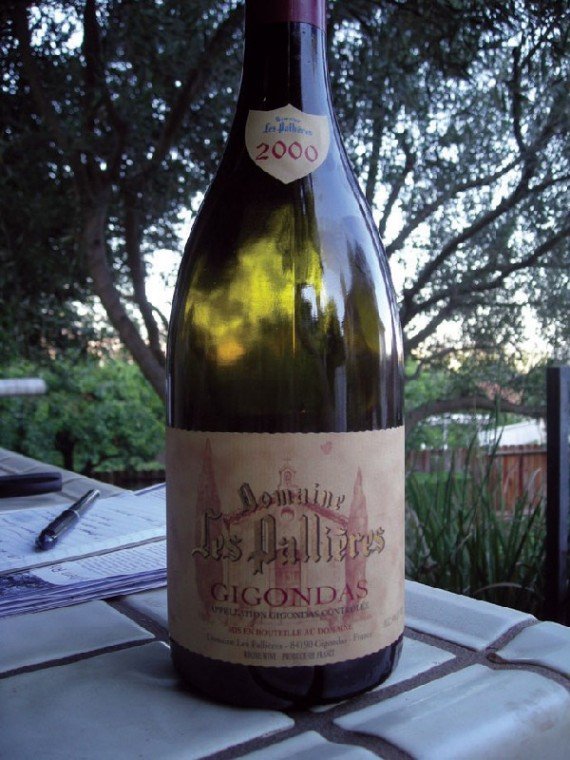There are many smaller, but still respected, wine areas all over
France. Some of the least known are producing some of the best
wines, especially for the price.
There are many smaller, but still respected, wine areas all over France. Some of the least known are producing some of the best wines, especially for the price.
Some wines from southern France were explored last week during a dinner party.
After our Bandol fix earlier in the evening, our dinner group tried three distinct red wines that would help polish off the main course of grilled vegetables and grilled lamb.
The 2000 Domaine les Pallières Gigondas was opened first. As a classic southern Rhône wine, it was comprised of Grenache, a very versatile grape that is the most widely planted. At $25, this wine was well-rounded, with nice black cherry fruit. This wine was starting to hit its stride, but a few more years might let it evolve fully.
Literally meaning “new castle of the Pope,” Châteauneuf-du-Pape can be made from any combination of 13 varietals in the area, the largest concentrations being Grenache, Mourvèdre and syrah. This wine region was the birthplace to the French AC or Appellations Contrôlees. Interestingly, the AC in Châteauneuf-du-Pape set a standard for the highest minimum percentage of alcohol at 12.5 percent.
We had to open the 2000 Vieux Telegraphe Châteauneuf-du-Pape “La Crau.” This particular wine was full-bodied, with a core of cassis and plum. It was structured great and had nice finish. Current vintages are available for around $30-45 dollars.
The Languedoc region in France can basically be divided into two areas: the red wine dominated Minervois and the more rugged terrain of Corbières. The soil in the Minervois is usually composed of clay and limestone. The soil in Corbières varies from sand, limestone, schist and even volcanic rock.
Our final red with the main course was a 2001 Domaine de Fontsainte Corbières “La Demoiselle”. This wine expressed flavors of vanilla, jammy fruit and all-spice. It had nice balance and soft tannins. Made mostly from the carignane grape, this wine is around $12.
A salad course was next, a combination of escarole, butter and red leaf lettuce. This was lightly tossed with a tarragon vinaigrette dressing.
To match with the salad, we tried two wines from the island of Corsica. Corsican wines, like the culture itself, can be seen as a melding of French and Italian influences.
We tried two wines from Domaine Maestracci, a 2004 E PROVE blanc and a 2001 E PROVE rouge. The white was made from the vermentino grape, the red from a clone of sangiovese. Both wines were under $15 and showcased versatility. The white was acidic, light and had a strong stone fruit character. The Bandol junkie called this wine “pooh-pooh” – meaning it was too delicate for his liking. The rest of us enjoyed it tremendously. The red wine was rustic and slightly austere. The aromas were of sea salt and Provencal herbs, which is why this wine went so well with the light salad course.
Our host threw us a slight curve when he brought out a California wine to sip while resting before dessert.
We enjoyed a zinfandel wine from Napa, a 2004 Talty Filice-Connolly vineyard. This old-vine wine was typical of today’s zinfandel. There was a lot of fruit in the nose and forward palate, mostly cherry, with some vanilla and a surprising sweetness. Even with the alcohol level just over 15 percent, the wine was nicely integrated, almost port-like.
To close the evening, we wanted to open a dessert wine, to be paired with an assortment of chesses – manchego, pecorino and petite Basque – and fresh fruit, including plucots (a cross of a plum and apricot) Granny Smith apples and Bing cherries.
We chose a 1997 Domaine Bru-Bache Jurancon. Jurancon is made in one of two styles: sweet or dry (sec). Ours was the sweet version that had about 14 percent alcohol and originally cost around $12. A pale straw color greeted us, accentuated by the candlelight on the table. Honey, orange blossoms, minerals and clove were the great aromas that were present, the wine soft and sweet – another great food and wine dinner complete.
Keep exercising your palate with different foods and different wines from some not-so-well known places!
Salud!














